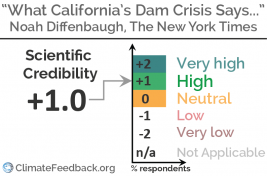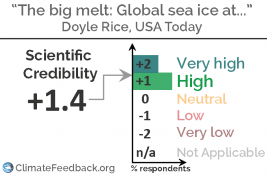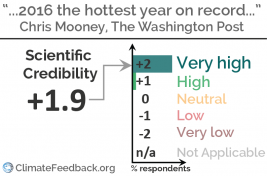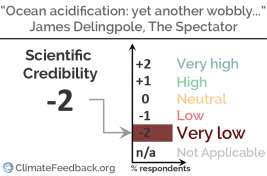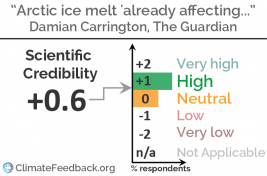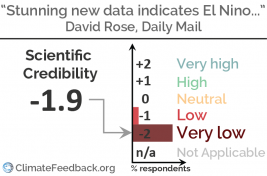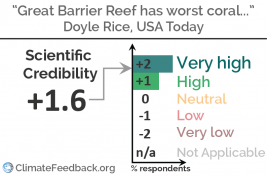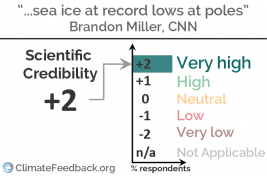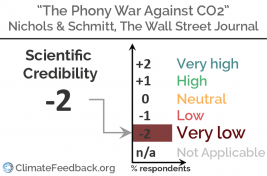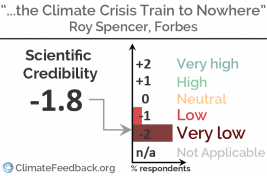Article Reviews
“Is this article consistent with the latest thinking and knowledge in science?”
“Would experts in this field endorse the main message of this article?”
These are the types of questions our “feedbacks” are designed to answer. If the feedback is positive, you can generally assume the information you’re reading is of high credibility. If it’s negative, however, you may want to read with extra care and attention — some of the information contained and conclusions reached are not consistent with science.[1]
Analysis of “What California’s Dam Crisis Says About the Changing Climate”
in The New York Times, by Noah Diffenbaugh
Warm dry years followed by extremely wet years have always been part of the climate of California, but warming can worsen both extremes by increasing evaporation, which makes droughts worse as well as put more moisture into the atmosphere allowing heavier downpours.
— 16 Feb 2017
Analysis of “The big melt: Global sea ice at record low”
in USA Today, by Doyle Rice
The five scientists who reviewed the article concluded that it is accurate. It properly conveys the core facts about global sea ice extent and the attribution of continuing sea ice loss to human-induced warming of the climate—primarily in the Arctic, as the low sea ice extent around Antarctica this year has not yet been clearly connected to climate change.
— 10 Feb 2017
Analysis of “U.S. scientists officially declare 2016 the hottest year on record. That makes three in a row.”
in The Washington Post, by Chris Mooney
"The article accurately conveys the US agencies' declaration of 2016 as the hottest year on record. It provides some good background material on why the agencies' numbers differ slightly (treatment of the Arctic) and the contributing roles of El Niño and man-made global warming."
— 19 Jan 2017
Analysis of “Ocean acidification: yet another wobbly pillar of climate alarmism”
in The Spectator, by James Delingpole
The scientists who have analyzed the article show that it contains significant inaccuracies, notably for its core assumptions, and misrepresents scientific studies and scientists it cites to make its point. Reviewers also note that the article knocks down strawman arguments that do not represent the state of scientific knowledge (scientists do not claim the ocean will become a “giant acid bath”).
— 10 Jan 2017
Analysis of “Arctic ice melt ‘already affecting weather patterns where you live right now'”
in The Guardian, by Damian Carrington
"The article nicely introduces some of the emerging science linking Arctic climate change to extreme weather at lower latitudes. There are no major inaccuracies and the author has sought expert comment form several prominent scientists. However, the article fails to fully capture the large uncertainty about how Arctic warming may influence weather in places further south and how big this effect might be."
— 21 Dec 2016
Analysis of “Stunning new data indicates El Nino drove record highs in global temperatures…”
in Daily Mail, by David Rose
This is an incredibly misleading article. It cherry picks a dataset taking measurements 2 miles up in the atmosphere only over land areas that disagrees with the other two datasets that examine the same values... The author is taking a normal modest cooling at the end of a large El Niño event and spinning it completely out of proportion.
— 02 Dec 2016
Analysis of “Australia’s Great Barrier Reef has worst coral die-off ever”
in USA Today, by Doyle Rice
"This article is mostly accurate ... the frequency of massive bleaching events is increasing, will continue to increase in the near future, and these events do not need to occur annually to kill the reef. The variability of El Niño Southern Oscillation on top of the background warming trend of surface temperatures means that we will exceed the bleaching thresholds more frequently."
— 30 Nov 2016
Analysis of “Amid higher global temperatures, sea ice at record lows at poles”
in CNN, by Brandon Miller
"Well outlined and balanced article, describing the evident link between low sea ice and climate warming and the melt-albedo feedback, but also mentioning the role of weather and short-time variability."
— 24 Nov 2016
Analysis of “The Phony War Against CO2”
in The Wall Street Journal, by Rodney Nichols and Harrison Schmitt
"The article speaks about scientific questions under an "opinion" banner—as if questions about the role of CO2 in the Earth system could be a matter of opinions. For the major final conclusion "With more CO2 in the atmosphere, the challenge [to feed additional 2.5 billion people] can and will be met.", there is absolutely no scientific credibility, nor support in the scientific literature—it is pure fantasy."
— 03 Nov 2016
Analysis of “Hillary Clinton Boards The Climate Crisis Train To Nowhere”
in Forbes, by Roy Spencer
"The article is inaccurate in several places and conveys that one must choose between solving immediate problems, such as poverty, and long-term risks such as climate change. We can do both, and indeed must do both if we take poverty seriously, since climate change disproportionately affects the poor."
— 29 Oct 2016
[1] Note: These feedbacks do not constitute endorsements of the author’s political or economic ideology, rather they are assessments of the scientific foundations and reasoning of the argumentation contained within each article.

